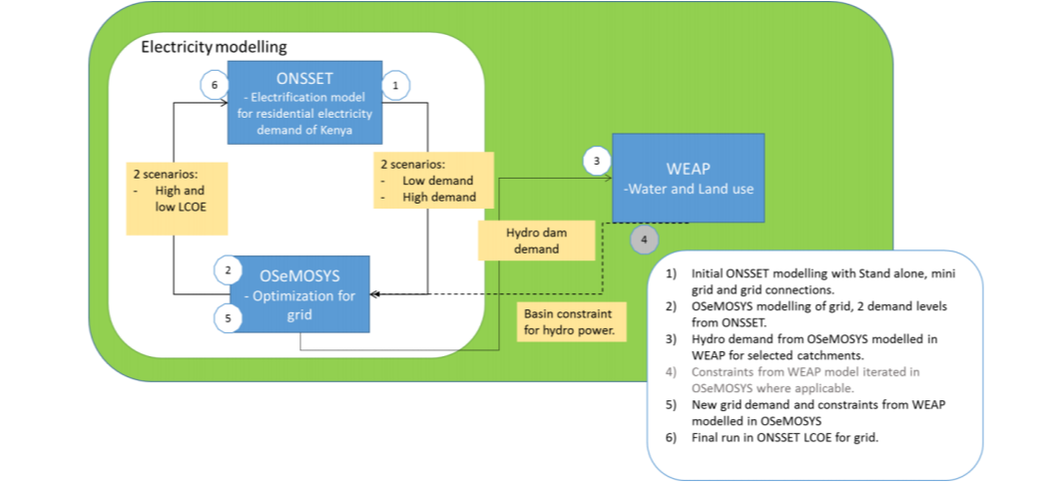About |
Energy, land and water are some of the most important resources of any nation. As countries tap into these resources to meet their development aspirations, policy makers need to take into account the various trade-offs and synergies that emerge from their management. Recent developments indicate that the interconnections among the use of natural resources and the economy are so important that policy decision making can significantly benefit from considering the full range of policy impacts in an integrated way; that is considering simultaneously how land, energy and water interplay in particular policy scenarios, as well as considering the impact of natural shocks on resource availability for economic growth and social development.
The CLEWs framework is currently being implemented for Uganda and Nicaragua. The projects use the Climate, Land-, Energy- and Water-use Strategies (CLEWs) methodology to implement the integrated assessment and draw, to the extent possible, from national and regional data, studies and models in the relevant areas. |
|
Mauritius CLEWs
|
Land, energy and water are our most precious resources, but the manner and extent to which they are exploited contributes to climate change. Meanwhile, the systems that provide these resources are themselves highly vulnerable to changes in climate. Efficient resource management is therefore of great importance, both for mitigation and for adaptation purposes. We postulate that the lack of integration in resource assessments and policy-making leads to inconsistent strategies and inefficient use of resources. We present CLEWs (climate, land-use, energy and water strategies), a new paradigm for resource assessments that we believe can help to remedy some of these shortcomings. [full paper available here]
|
|
Uganda and Nicaragua CLEWs
|
Uganda and Nicaragua have taken important steps to promote sustainable development and confront climate change. The National Plans in both countries clearly point in this direction. The drafting of the upcoming Sustainable Development Reports will in turn provide further guidance to strategically advance sustainable development and tackle the challenges of a changing climate. The Ministry of Finance, Planning and Economic Development, the United Nations Development Program, and the United Nations Department of Economic and Social Affairs, New York, have been conducting capacity building projects to inform policy making for development policies stemming from economy-wide and energy systems dynamic models. These tools have been used to assist the preparation of, among others, MDG reports, government working papers, and of the National Development Plan. These projects expand the type of issues and policies that can be informed by incorporating, in an integrated platform, the insights of models and diagnostic tools to assess the use of water, land and energy under the current and expected climate conditions in the country.
The aim of the projects is to support Uganda’s and Nicaragua’s efforts to formulate more comprehensive and better articulated sustainable development policies. In particular, they aim to contribute to the stock knowledge feeding the drafting of the Sustainable Development Reports. Project activities also include training workshops where details of the methodology, its weaknesses and strengths, will be explained and participants will be familiarized with the results and tools developed for the assessment. This project is implemented by KTH-dESA in partnership with UNDESA. |
|
Bolivia CLEWs
|
Detailed water and energy systems models were developed in WEAP and OSeMOSYS for this study. In addition to these tools, the Open Source Spatial Electrification Toolkit (ONSSET) was soft linked with OSeMOSYS for a more precise representation of the electrification plans for achieving different tiers of electricity access. The integrated assessment, though the articulated combination of the different sectoral models, allowed for the identification of key interlinkages between the land use (agriculture), water and energy sectors considering the aggressive natural gas and hydropower expansion in Bolivia. The study also covered the estimation of the cost of new infrastructure to meet the sustainable development goal no. 7 (energy access to all by 2030) under a changed climate.
|
|
Kenya
CLEWs |
In Kenya only 23% of the population have electricity access and in the rural areas 93% lack access to electricity and the improved water availability only reaches 59% of the population. In Kenya 72% of the agricultural land is rain fed which makes the food availability sensitive to droughts, which happened in 2009, and in 2012-2014 22% of the population was undernourished. The main objective for this work was to explore how Kenya could ahieve selected Sustainable Development Goals with an integrated resources planning following the CLEWs framework. The toolset used for this analysis results on the combination of ONSSET, OSeMOSYS could be allocated to reach the selected SDGs.
|

